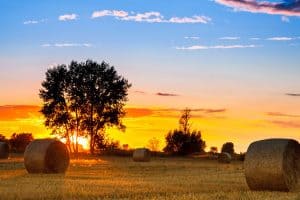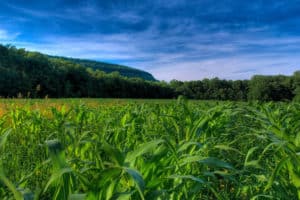“Men, it has been well said, think in herds; it will be seen that they go mad in herds, while they only recover their senses slowly, one by one.” Charles MacKay, Extraordinary Popular Delusions and the Madness of Crowds
This quotation comes from MacKay’s 1841 book that focuses on three speculative bubbles during the 17th and 18th centuries. Asset values getting overheated is not a new happening and the herd mentality MacKay describes is still alive and well 170 years later. We’ve seen it with internet stocks and residential housing recently, and both of those bubbles were very easy to identify – at least with the benefit of hindsight. But it is exceedingly difficult to predict the path of asset prices, as differentiating between market values that have increased based on fundamentals and market values that have lost touch with reality is growing more and more difficult. That being said, let’s consider the possible answers to the question, have farmland prices risen too far, too fast?
Asset Bubble vs. Credit Bubble
Speculative bubbles in any asset class are as much a behavioral phenomenon as they are a financial one. Rising values create a positive feedback loop where excess returns lead to more demand for the asset by new investors. When your neighbor doubles his 401(k) in six months from buying Pets.com or ThisCompanyHasNoRevenue.com, it’s hard to resist the temptation to invest. After all, who wants to be left behind? This is a positive feedback loop, and the beginning of an asset bubble. The end of an asset bubble, not surprisingly, is driven by a negative feedback loop. Investment losses lead to fear, which leads to more sellers than buyers, which leads to more investment losses and so on until asset prices fall enough for the market to clear. It’s the same sequence of greed followed by fear that has driven investor behavior since beads were traded for spices.
A related occurrence, and often a much more dangerous one, is a credit bubble. The recent subprime mortgage crisis is a prime example. The debate continues as to the primary causes of the crisis, with the leading candidates being government policies on housing, accommodative monetary policy by the Fed, and lax lending standards by banks. All three played a part in the crisis, and have played a part in pumping an excessive amount of liquidity into the housing market through mortgage loans. This credit bubble was fuel on the fire of unsustainable home price increases. And this is why a credit bubble can be so dangerous – when you add the bank’s money on top of the investor’s money all chasing the same investment, prices are bound to get way out of line. Cleaning up the mess once the bubble bursts is more difficult, as well, because the painful process of deleveraging must occur. The U.S. economy is still nursing this debt hangover three years after the last subprime loan was made.
Unlike the housing market, farmland is likely not in a credit bubble today, but investors and lenders will need to remain prudent to keep it that way. We are hearing from our Farm Credit counterparts in the Midwest (where the most significant land value increases have occurred) that many sales are on a cash basis and the financed transactions meet conservative guidelines for down payments. The lenders have looked at the long-run price of corn and soybeans, and used that to set a land value that would cash flow if commodity prices fall back to “normal” levels. If these practices continue, a credit bubble forming and pushing land values even higher is very unlikely. But, experience shows us that if a few lenders start making poor underwriting decisions and this gains them market share, it becomes increasingly difficult for other lenders to stand idly by while their loan volumes shrink. Let’s hope agricultural lenders learned a lesson from the mistakes residential lenders made leading up to the subprime crisis.
Farm Balance Sheets
On average, the financial position of farmers is as good today as ever in recent history. Producers deleveraged coming out of the 1980s farm crisis, and have maintained low to moderate debt levels since. Balance sheets are further buoyed by higher land values (the primary asset for most farmers) and strong profitability the last several years. Farmers are much better prepared for a decline in land values than they were in the early 1980s. Debt-to-equity percentages have fallen from 29% in 1985 to 13% in 2010. It can be argued that a drop in values would not cause a rush of forced selling and the negative feedback loop mentioned earlier. This is the story we’re hearing today from financial industry regulators and many Federal Reserve Bank economists. Of course, this makes an assumption that farmers are the primary buyers of farmland.
Who’s Buying the Farm?
Investors (i.e. not a farmer) are increasingly the buyers of farmland, particularly highly-productive Midwest cropland. Depending on which researcher you ask, investors make up 30-45% of recent sales. And these levels are on the rise. With opportunities for good investments harder to find these days, the “smart money” is turning to the red-hot agricultural sector. This has no doubt had some influence on the trajectory of prices in recent years. But is investor participation a bad thing for the farmland market? Not necessarily, but it could be a harbinger of bad things to come. While I’m sure that the investment groups new to agricultural investments are very intelligent folks, usually when you see a flood of relatively inexperienced participants in a market you have the beginnings of a bubble. Just think of all the stories you’ve heard of people being wiped out by tech stocks or buying multiple condos at the beach, when they really weren’t prepared to put a significant amount of their net worth toward these investments. If you’re interested in monitoring farmland values, I would recommend keeping an eye on the percentage of farmland purchases by investors. We would have been well-served to monitor this statistic in the housing market leading up to the crash as an indicator of an over-heated sector.
Cash is King
Whether you’re buying farmland as a passive investment or a way to make your living, cash flow from the investment should be the driver of value. Investors are concerned with rental rates, which have increased significantly in recent years although slower than the pace of the land itself. For instance, land rent in Iowa is up over 11% from 2010, but the ratio of rent to land value has steadily declined from 5.9% in 2001 to 3.4% in 2011. This decline is somewhat concerning, but still affords a reasonable return when inflation and a small appreciation factor are added. But, if commodity prices fall back to historical levels, farmers will not be willing or able to pay the higher rents we are seeing today. Obviously, this will have a direct impact on the value of the farmland.
As for farmers, their crop yields have steadily increased due to improved seed varieties, enhanced management practices, and more efficient use of each acre of land. Historically high commodity prices combined with these increased yields have obviously boosted farm incomes. It’s arguable whether the higher income fully supports the significant increases in prices paid for high-quality farmland, but at least there is some financial underpinning of the record value levels.
As mentioned previously, asset bubbles are very hard to predict without the benefit of hindsight, and it’s even harder to get the timing right. Many investors went broke shorting the subprime market. Right idea, wrong time. At this point, the jury is still out on whether farmland is currently in a bubble, but hopefully the four potential drivers of an overheated land market will help you decide for yourself as this chapter of the land story unfolds.
This content may not be used or reproduced in any manner whatsoever, in part or in whole, without written permission of LANDTHINK. Use of this content without permission is a violation of federal copyright law. The articles, posts, comments, opinions and information provided by LANDTHINK are for informational and research purposes only and DOES NOT substitute or coincide with the advice of an attorney, accountant, real estate broker or any other licensed real estate professional. LANDTHINK strongly advises visitors and readers to seek their own professional guidance and advice related to buying, investing in or selling real estate.









Mr. Purvis is well to address the issue of deleveraging in the economy. Asset bubbles are always followed by a long and bumpy period of debt consolidation and recapitalization that can whipsaw paper securities as well as commodities. Assuming the long-term growth of the global economy and improving diets in the developing world the prognosis for agriculture is good. Headwinds will no doubt develop in regard to government subsidies which become problematic in light of current budget deficits. Energy and fertilizer prices may be kept somewhat in line by more fossil fuel (i. e. natural gas) development if the regulatory climate allows. I do like the question: Will the farmer be able to afford those higher rents? For an agri-investor like myself in the Arkansas Delta that is a query that remains to be answered. All-in-all, a very good article. Thank you, Mr. Purvis.
Zack,
Good article I agree that there may not be a credit bubble due to the liquidity of the farming community, but that does not mean that there is not an asset bubble in land values and a very inflated commodities market. It will be interesting to see what happens if commodities take a dive and wall street decides to inflate another sector of the economy.
I find it interesting that article after article asks about the farmland bubble and compares it to the recent subprime mortgage debacle in the US. You are talking about two totally different assets with non-income residential real estate and income producing farmland. I understand you are not talking about the assets but the financing/value mechanism to obtain those assets. You are well to mention agland today requires large downpayments of cash here in Iowa something that is completely opposite of the subprime mortgage crisis. Many of my buyer clients are putting 35% to 50% down and more than 50% of them are paying 100% cash at closing with no financing. Those that are financing are doing it at very low interest rates, opposite the subprime crisis. We continue to see these “shocking” numbers $16,740 per acre or $15,000 per acre in the newspapers but the truth is the average cost of an acre of farmland in Iowa is $5056 as of Jan 2011. The newspapers are showing the extremes in most cases. There are many farms selling in the $7000 range this year, the prices are still sharply up again this fall. Is it to high? Well certainly commodity prices could fall to lower numbers but with the shortages we have now and a growing population, ever increasing uses for grain and new markets overseas its very unlikely that we will see that. Agriculture has turned a corner and while many ask if its to high those of us that have lived amid grain production our entire lives are saying “wow, its finally caught up”
I had lunch with an older farmer from Alabama the other day and he told me that in 1939, his grandfather was offered several hundred acres of land that joined his farm for $4 per acre. The grandfather declined saying he couldn’t do anything with it if it was given to him. His grandson, the older farmer I was eating with, and a few other relatives ended up buying that same adjoining farmland in the late 70’s for $400 per acre. I think the moral is land values generally trend upward, and good ag land is probably not going to get cheaper…ever.
Good Article! I agree land may go down a bit from time to time, but will always trend upwards, I buy scenic mississippi riverview property in Iowa, the increase in land prices will slow down the aquisition of these properties as the price of farmland increases, but I am happy for the farmers and happier to see some of the land held in reserve programs now being farmed again. Hopefully a balance between land being developed for rural residential lots, land laying idle and being cropped can be maintained.
I agree that this is a good article. Mr. Purvis is hitting the nail on the head in stating that the cash flow should be the driver of value. While increased yields and crop prices can support some increase in good crop land, the accompanying rise in pasture land is getting totally out of line. Stocking rates would have to be cut to one quarter of normal for my area, or calf prices would have to be multiplied by a factor of three to insure an adequate cash flow to make the prices work! Rookie or speculative investors just don’t understand that!
I am a fifth generation rancher in west central SD. My grandfather told how they wondered how they were ever going to pay for land when it was $0.50 to $1.00 an acre, but the thing was their gross margins were such that it could work. We don’t enjoy the 50-75% margins they had!